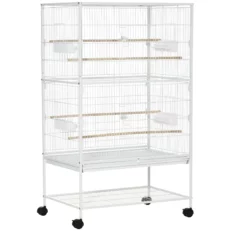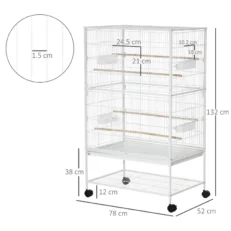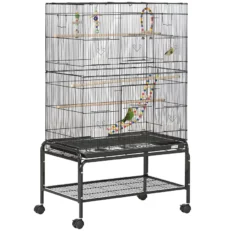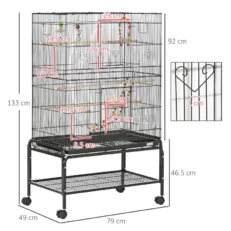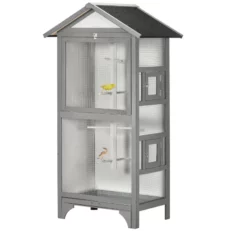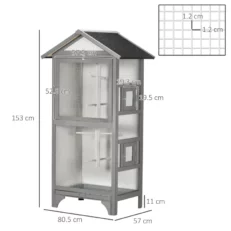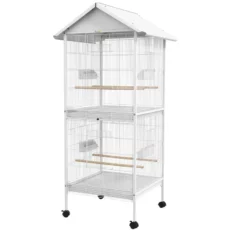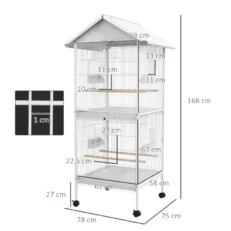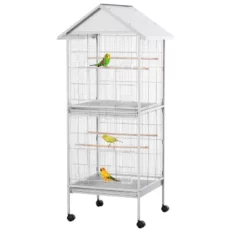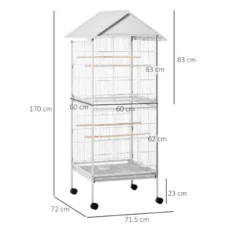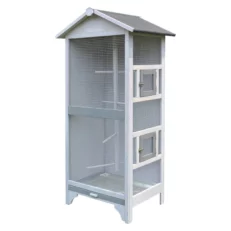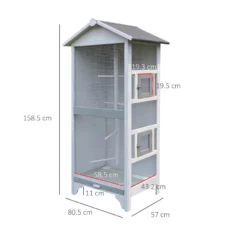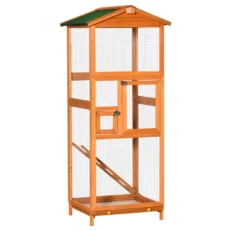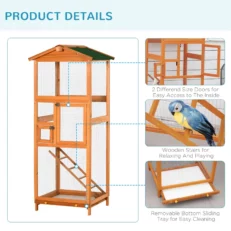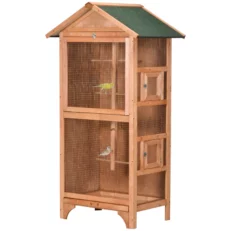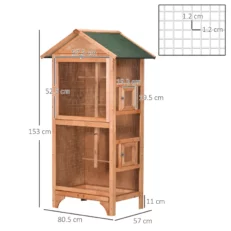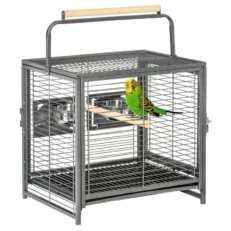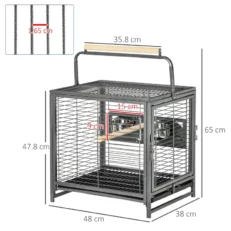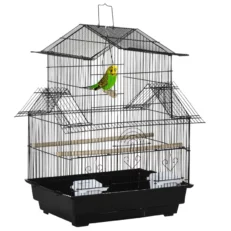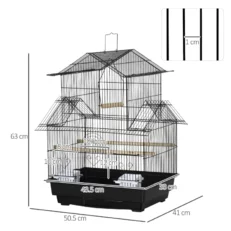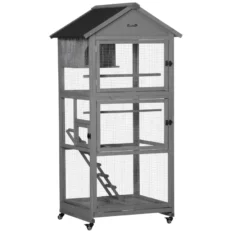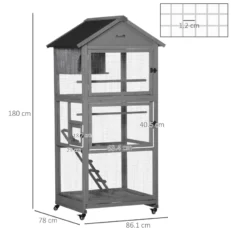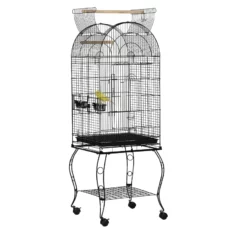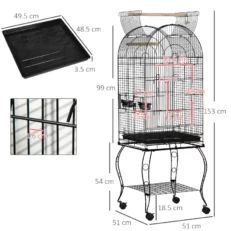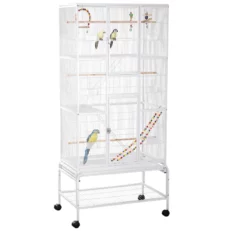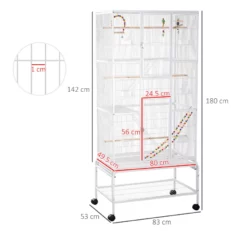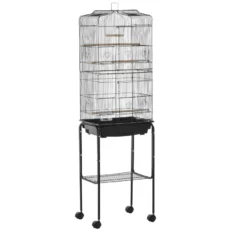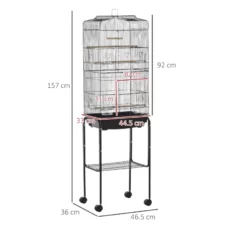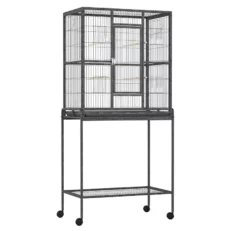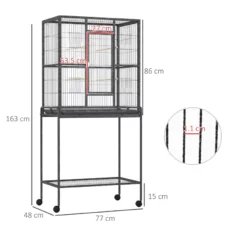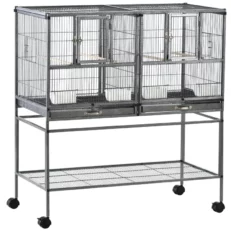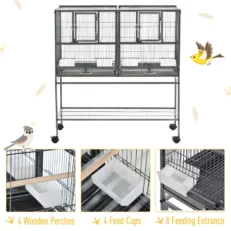
The Ultimate Guide to Choosing the Perfect Bird Cage: A Comprehensive Buying Resource for New and Experienced Bird Owners
As a new bird owner or someone who has never delved into the world of parrot cages before, the task of selecting the right cage for your feathered friend can be quite daunting. You may find yourself bombarded with questions such as:
- How do I determine the appropriate size of the cage for my parrot?
- What considerations should I keep in mind if I have multiple birds?
- Should I opt for stainless steel or powder-coated cages?
- Does the brand name really make a difference?
With all this uncertainty, we understand the need for a comprehensive guide to help you navigate through the process of choosing the perfect cage for your beloved bird. This guide aims to provide you with the essential knowledge and practical tips necessary to make an informed decision.
From determining the ideal cage size and considering bar spacing to evaluating the benefits of stainless steel versus powder-coated options, we cover every aspect to ensure that you have all the information you need. We also address the concerns of bird owners who have multiple feathered companions and explore how to select a cage that accommodates their needs.
In addition to the technical aspects, we shed light on whether the brand name truly matters and provide insights into the factors you should consider when evaluating different bird cage manufacturers.
With this comprehensive buying guide, we aim to alleviate your concerns and empower you with the knowledge required to make a confident and well-informed decision. By the end, you’ll be equipped to choose the perfect cage that meets both the practical requirements and the unique preferences of your cherished bird.
Navigating the Maze: Choosing the Perfect Bird Cage for Your Feathered Friend
Disclaimer: As much as we wish there was a one-size-fits-all solution, the truth is that every bird has its unique lifestyle and living situation. Some birds freely explore your home throughout the day, only returning to their cage for sleep. Others cohabitate with multiple companions in a shared enclosure. Some are avid flyers within their cage, while others prefer a more tranquil environment. The variations are endless.
Given these diverse circumstances, we cannot provide exact recommendations for each individual bird. However, what we can offer are fundamental principles that will guide you in selecting the ideal cage for your feathered friend’s specific situation.
Our Approach: In this guide, we focus on equipping you with essential knowledge and guiding principles rather than rigid rules. We understand that your bird’s needs may differ from others, and it is crucial to consider factors such as their size, behavior, and daily routine when making your decision.
Our aim is to provide you with a comprehensive understanding of the key elements to consider when choosing a cage. By gaining insights into these fundamental principles, you will be empowered to assess your bird’s unique requirements and select a cage that meets their individual needs.
Let’s Dive In: With this disclaimer in mind, let’s delve into the exciting journey of selecting the perfect cage for your feathered companion. We will explore important aspects such as size, design, materials, and additional considerations that will assist you in making an informed choice.
Get ready to embark on this adventure as we guide you through the maze of bird cage selection, ensuring that your feathered friend has a safe, comfortable, and stimulating home tailored to their specific needs.
Step 1: Bar Spacing – Ensuring Safety and Promoting Physical Activity
When choosing a bird cage, one of the most crucial factors to consider is the bar spacing. Unlike other aspects of cage selection, bar spacing is non-negotiable and requires careful attention. The primary goal is to ensure that your bird cannot stick its head between the bars.
The ideal bar spacing serves multiple purposes. Firstly, it prevents escape attempts and potential injuries. Secondly, it promotes physical activity by allowing your bird to climb, fly, and play within the cage. To determine the appropriate bar spacing for your bird, refer to our popular Bar Spacing Guide.
In the guide, you will find a helpful chart that provides recommended bar spacing for various bird species. Simply locate your bird’s species and click for more specific details. This valuable resource will assist you in selecting a bird cage with the appropriate bar spacing, ensuring the safety and well-being of your feathered friend while encouraging their natural behaviors.
Remember, bar spacing is a critical consideration that should not be overlooked. By following this important first step, you lay the foundation for a secure and enriching environment for your bird.
Step 2: Internal Living Space – Providing Comfort and Room to Thrive
Next to bar spacing, ensuring an adequate internal “living space” within the cage is of utmost importance. It is crucial to avoid crowding your bird and provide them with sufficient room to move comfortably. By offering ample internal space, you contribute to your bird’s overall health and well-being, preventing potential attitude and health problems that can arise from feeling confined.
While considering the internal living space, it is vital to account not only for your bird but also for essential items that occupy space within the cage. Toys, food dishes, water bowls, treat dispensers, and perches are all crucial elements that promote intellectual stimulation and fulfill your bird’s instincts. However, selecting a cage that is large enough will ensure that these accessories do not overcrowd the cage, allowing your bird to navigate and utilize the space freely.
Different bird species have distinct needs. Smaller species such as Canaries, Doves, Finches, Lovebirds, and Parakeets require wider cages, as they tend to travel side-to-side. On the other hand, medium and larger birds have their specific requirements. It is essential to apply common sense and consider factors such as the size of your bird and your lifestyle. If you have a larger bird or spend extended periods away from home, opt for a larger cage. Providing a spacious cage allows birds to move about freely, akin to how we navigate our homes.
In general, the size of the bird determines the necessary internal living space. Ensure that the cage is large enough for your bird to turn around comfortably without their feathers rubbing against the bars. Additionally, when perched, their tail should not touch the cage sides or bottom.
By prioritizing the appropriate internal living space, you create a comfortable and enriching environment for your feathered companion. This ensures that they can fully express their natural behaviors and thrive in their home within the cage.
Step 3: The Look – Harmonizing Style and Aesthetics
Once you have considered the essential health and happiness factors for your bird, it’s time to turn your attention to the look and design of the cage. As devoted parrot parents, we understand the importance of a cage that not only meets your bird’s requirements but also complements your personal style and living space.
The cage may find its place in a casual family room, an elegant living room, or even a dedicated bird room if you’re fortunate enough to have one! We strive for a cage that exudes quality craftsmanship while seamlessly integrating into the overall aesthetics of the room or space it occupies.
When selecting a cage, it is recommended to consider not only the colors of the surrounding environment but also the color of your bird. A cage serves as a showcase for your beloved feathered friend, and it is essential to choose a color that contrasts well with the dominant hues of your bird’s plumage. Opting for a contrasting color enhances the visual appeal and allows for a more captivating view of your bird from outside the cage.
Remember, a cage is not merely a functional item but also a piece of decor that adds to the ambiance of your living space. By carefully considering the look and design, you can ensure that your bird’s cage not only meets their needs but also complements your personal style, creating a harmonious and aesthetically pleasing environment for both you and your feathered companion.
In conclusion, by finding a cage that strikes the perfect balance between functionality, comfort, and visual appeal, you can create a space that not only meets the needs of your bird but also enhances the overall beauty of your living space.
Stainless Steel vs Powder-Coated: Making the Right Choice for Your Bird’s Cage
When it comes to selecting a cage finish, you’ll commonly come across two options: stainless steel and powder-coated. Each option has its own advantages and considerations. Let’s delve into the pros and cons of both to help you make an informed decision.
Stainless Steel: Pros:
- Durability: Stainless steel cages are highly resistant to rust, corrosion, and chipping, ensuring long-term durability.
- Hygiene: Stainless steel surfaces are smooth and easy to clean, making it simpler to maintain a sanitary environment for your bird.
- Aesthetics: The sleek and timeless appearance of stainless steel complements various interior styles and colors.
- Safety: Stainless steel is non-toxic and does not release any harmful substances that could potentially endanger your bird’s health.
- Longevity: With proper care, stainless steel cages can last a lifetime, providing excellent value for your investment.
Cons:
- Cost: Stainless steel cages generally come at a higher price point compared to powder-coated cages, making them less budget-friendly.
- Limited Color Options: Stainless steel cages typically offer a more limited range of color choices compared to powder-coated cages.
Powder-Coated: Pros:
- Versatility: Powder-coated cages come in a wide array of colors, allowing you to find a cage that matches your style and decor.
- Affordability: Powder-coated cages are generally more budget-friendly compared to stainless steel cages.
- Aesthetics: The textured finish of powder-coated cages adds visual interest and can complement various room designs.
Cons:
- Durability: Over time, the powder coating may chip or wear off, exposing the underlying metal to potential rust or corrosion.
- Cleaning Challenges: The textured surface of powder-coated cages can make cleaning a bit more challenging compared to smooth stainless steel surfaces.
- Potential Toxicity: If the powder coating becomes damaged or begins to deteriorate, it may pose a risk of ingestion for your bird.
Ultimately, the choice between stainless steel and powder-coated cages depends on your priorities, budget, and preferences. Stainless steel offers superior durability, hygiene, and longevity, but comes at a higher cost. Powder-coated cages offer versatility and affordability, but may require more care and maintenance over time.
Consider your specific needs, the environment in which the cage will be placed, and the well-being of your bird when making your decision. Both options can provide a safe and comfortable home for your feathered companion, so choose the one that best aligns with your circumstances and priorities.
Recommended cage bar spacing for your pet bird
Budgerigar (Budgie):
- Recommended Bar Spacing: 1/2 inch (12.7 mm)
Cockatiel:
- Recommended Bar Spacing: 1/2 to 5/8 inch (12.7 to 15.875 mm)
Parakeet (other than Budgerigar):
- Recommended Bar Spacing: 1/2 inch (12.7 mm)
Lovebird:
- Recommended Bar Spacing: 1/2 inch (12.7 mm)
African Grey Parrot:
- Recommended Bar Spacing: 3/4 to 1 inch (19 to 25.4 mm)
Canary:
- Recommended Bar Spacing: 1/2 inch (12.7 mm)
Finch:
- Recommended Bar Spacing: 1/2 inch (12.7 mm)
Conure:
- Recommended Bar Spacing: 1/2 to 3/4 inch (12.7 to 19 mm)
Amazon Parrot:
- Recommended Bar Spacing: 3/4 to 1 inch (19 to 25.4 mm)
Cockatoo:
- Recommended Bar Spacing: 3/4 to 1 inch (19 to 25.4 mm)
Macaw:
- Recommended Bar Spacing: 3/4 to 1.5 inches (19 to 38 mm)
Quaker Parrot (Monk Parakeet):
- Recommended Bar Spacing: 1/2 to 5/8 inch (12.7 to 15.875 mm)
Senegal Parrot:
- Recommended Bar Spacing: 1/2 to 3/4 inch (12.7 to 19 mm)
Ringneck Parakeet:
- Recommended Bar Spacing: 1/2 to 3/4 inch (12.7 to 19 mm)
Eclectus Parrot:
- Recommended Bar Spacing: 3/4 to 1 inch (19 to 25.4 mm)
Poicephalus Parrot:
- Recommended Bar Spacing: 1/2 to 3/4 inch (12.7 to 19 mm)
Lorikeet:
- Recommended Bar Spacing: 1/2 to 5/8 inch (12.7 to 15.875 mm)
Caique:
- Recommended Bar Spacing: 1/2 to 3/4 inch (12.7 to 19 mm)
Dove:
- Recommended Bar Spacing: 1/2 to 5/8 inch (12.7 to 15.875 mm)
Pionus Parrot:
- Recommended Bar Spacing: 1/2 to 3/4 inch (12.7 to 19 mm)
It’s important to remember that the appropriate bar spacing is crucial to ensure the safety and comfort of your pet bird. The spacing should be small enough to prevent the bird from sticking its head through the bars, but large enough for the bird to comfortably move around and play. Always consider the size and species of your bird when selecting a cage.

